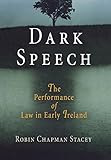Dark Speech : The Performance of Law in Early Ireland / Robin Chapman Stacey.
Material type: TextSeries: The Middle Ages SeriesPublisher: Philadelphia : University of Pennsylvania Press, [2016]Copyright date: ©2007Description: 1 online resource (368 p.)Content type:
TextSeries: The Middle Ages SeriesPublisher: Philadelphia : University of Pennsylvania Press, [2016]Copyright date: ©2007Description: 1 online resource (368 p.)Content type: - 9780812239898
- 9780812294040
- 349.41509
- KDK156.S73 2007
- online - DeGruyter
- Issued also in print.
| Item type | Current library | Call number | URL | Status | Notes | Barcode | |
|---|---|---|---|---|---|---|---|
 eBook
eBook
|
Biblioteca "Angelicum" Pont. Univ. S.Tommaso d'Aquino Nuvola online | online - DeGruyter (Browse shelf(Opens below)) | Online access | Not for loan (Accesso limitato) | Accesso per gli utenti autorizzati / Access for authorized users | (dgr)9780812294040 |
Browsing Biblioteca "Angelicum" Pont. Univ. S.Tommaso d'Aquino shelves, Shelving location: Nuvola online Close shelf browser (Hides shelf browser)

|

|

|

|

|

|

|
||
| online - DeGruyter Existential Threats : American Apocalyptic Beliefs in the Technological Era / | online - DeGruyter Deportation : The Origins of U.S. Policy / | online - DeGruyter Food on the Page : Cookbooks and American Culture / | online - DeGruyter Dark Speech : The Performance of Law in Early Ireland / | online - DeGruyter Contested Bodies : Pregnancy, Childrearing, and Slavery in Jamaica / | online - DeGruyter Franciscans and the Elixir of Life : Religion and Science in the Later Middle Ages / | online - DeGruyter Modern Coliseum : Stadiums and American Culture / |
Frontmatter -- Contents -- Introduction -- 1. The Play's the Thing -- 2. Jurists on Stage -- 3. The Power of the Word -- 4. Voicing Over -- 5. Voices Within the Law -- Conclusion: The Dangers of Performance -- List of Abbreviations -- Notes -- Bibliography -- Index -- Acknowledgments
restricted access online access with authorization star
http://purl.org/coar/access_right/c_16ec
What does it mean to talk about law as theater, to speak about the "performance" of transactions as mundane as the sale of a pig or as agonizing as receiving compensation for a dead kinsman? In Dark Speech, Robin Chapman Stacey explores such questions by examining the interaction between performance and law in Ireland between the seventh and ninth centuries.Exposing the inner workings of the Irish legal system, Stacey examines the manner in which publicly enacted words and silences were used to construct legal and political relationships in a society where traditional hierarchies were very much in flux.Law in early Ireland was a verbal art, grounded as much in aesthetics as in the enforcement of communal norms. In contrast with modern law, no sharp distinction existed between art and politics. Visualizing legal events through the lens of procedure, Stacey helps readers recognize the creative, fluid, and inherently risky nature of these same events.While many historians have long realized the mnemonic value of legal drama to the small, principally nonliterate societies of the early Middle Ages, Stacey argues that the appeal to social memory is but one aspect of the role played by performance in early law. In fact, legal performance (like other more easily recognized forms of verbal art) created and transformed as much as it recorded.
Issued also in print.
Mode of access: Internet via World Wide Web.
In English.
Description based on online resource; title from PDF title page (publisher's Web site, viewed 24. Apr 2022)


